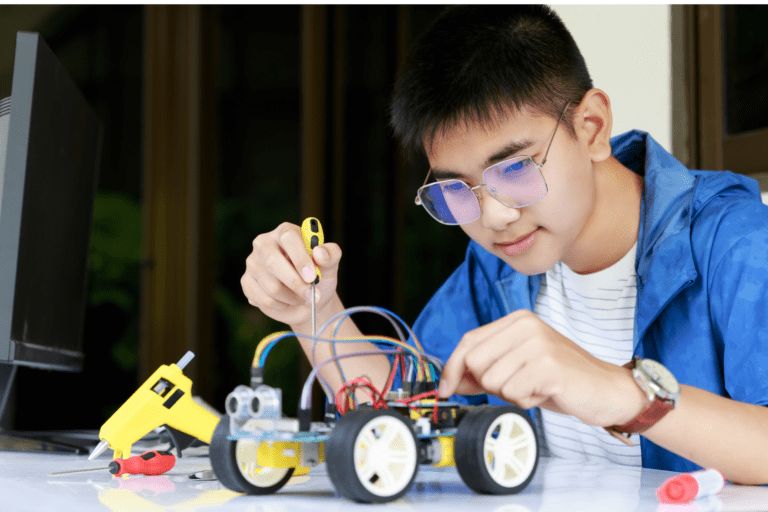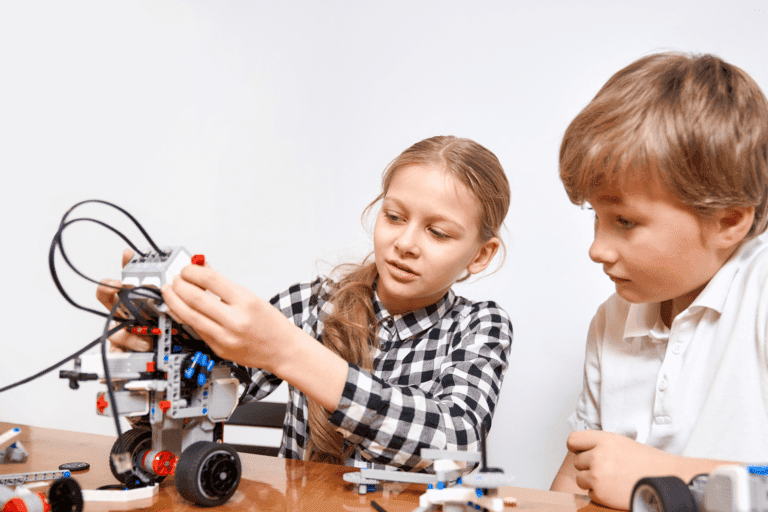The Science Behind Play: Why Hands-On STEM Learning Works
In today’s fast-paced, technology-driven world, getting kids excited about learning can be challenging. However, when play meets education, something magical happens—especially in STEM (Science, Technology, Engineering, and Mathematics). Hands-on STEM learning, through fun, engaging projects, taps into children’s natural curiosity and creativity. But what is it about hands-on play that makes STEM so effective?
Here, we’ll explore the science behind why hands-on learning works and how you can harness its power at home or in the classroom to inspire a lifelong love for STEM subjects.
1. Kinesthetic Learning: Learning by Doing
Children, especially in their early years, are kinesthetic learners. This means they learn best through movement and hands-on experiences rather than passive methods like listening or reading. When kids engage in STEM activities—such as building a balloon-powered car or constructing a solar-powered helicopter—they’re using their hands and minds together to solve problems.
This type of learning helps children make sense of abstract concepts. For instance, learning about physics principles like force and motion becomes more tangible when kids see their balloon-powered car zoom across the floor. These hands-on experiences help cement key concepts that may otherwise seem confusing.
Why it works:
Kinesthetic learning activates multiple areas of the brain, strengthening connections between knowledge and real-world application. By “learning by doing,” children better retain information and are more likely to recall it later on.
2. STEM Fosters Problem-Solving Skills
STEM activities naturally involve trial and error, which promotes problem-solving. Whether kids are tasked with designing a bridge that won’t collapse or figuring out how to wire a simple circuit, STEM projects challenge them to think critically and find solutions.
Hands-on STEM activities teach kids that it’s okay to fail—and, more importantly, that failure is a stepping stone to success. For instance, if a child’s robot doesn’t move the way they intended, they’ll need to troubleshoot, make adjustments, and test new solutions until it works.
Why it works:
Problem-solving builds resilience and confidence. It also develops critical thinking and reasoning skills, helping children approach challenges from multiple angles. These are essential skills, not only in STEM subjects but in everyday life.
3. Hands-On STEM Learning Engages Multiple Senses
One of the key reasons hands-on STEM projects work so well is because they engage multiple senses—sight, touch, hearing, and sometimes even smell! For example, in a project like making slime, kids are feeling the texture, observing how the slime changes, and sometimes even hearing the squishy sounds as they stretch it out.
Engaging multiple senses during play helps children make stronger connections between what they’re doing and what they’re learning. Sensory experiences create a more immersive and enjoyable learning environment, making STEM subjects more relatable and fun.
Why it works:
Multi-sensory learning helps to deepen understanding and reinforces learning. The more senses a child uses during an activity, the more likely they are to remember the experience and the concepts they learned.
4. STEM Encourages Creativity and Innovation
STEM isn’t just about science and math—it’s also about creativity and innovation. When kids engage in hands-on projects, they’re not only solving problems but often coming up with entirely new ideas. For example, while building a LEGO structure, kids may experiment with different designs, imagining their own creations beyond what’s provided in the instructions.
This combination of creativity and technical thinking is exactly what drives innovation in fields like engineering, technology, and science. By introducing kids to STEM through hands-on play, we help foster an innovative mindset that could one day lead to groundbreaking discoveries.
Why it works:
Creativity and innovation are the engines of progress. Hands-on STEM activities encourage kids to think outside the box, experiment with new ideas, and combine different concepts in original ways—all while having fun!
5. Boosting Engagement and Motivation
Kids naturally love to play, and when learning feels like play, they’re more engaged. Hands-on STEM projects turn traditional learning into an exciting, interactive experience that keeps children motivated. Rather than sitting through lectures or reading about science in textbooks, they’re actively participating in creating and discovering.
For example, a child learning about renewable energy can build a wind-powered house or design a wind turbine. The sense of accomplishment when a project is completed successfully boosts their self-esteem and motivates them to keep learning.
Why it works:
Engaged learners are motivated learners. Hands-on STEM activities ignite curiosity and provide immediate, satisfying feedback that inspires kids to continue exploring and learning.
How to Start Hands-On STEM Learning at Home
If you’re looking for a way to bring the benefits of hands-on STEM learning into your home, consider trying simple DIY projects that promote exploration and play. From building bridges out of straws to creating homemade slime, there are endless opportunities for hands-on learning right in your living room.
And for parents who want a more structured approach, STEMKids Subscription Boxes are the perfect solution. Each box comes packed with exciting, hands-on STEM projects designed to teach key concepts in science, technology, engineering, and math—all while sparking creativity and fun. With everything you need delivered to your door, it’s never been easier to get started with STEM learning at home.
Why Hands-On STEM Learning Matters
Hands-on learning transforms STEM subjects from intimidating concepts into approachable, fun activities. By engaging multiple senses, fostering creativity, and promoting problem-solving skills, hands-on STEM experiences lay the groundwork for a lifetime of curiosity and learning.
At STEMKids, we believe every child has the potential to become the next great innovator. Whether you’re an educator looking to enrich your classroom or a parent wanting to inspire learning at home, our hands-on STEM kits and subscription boxes provide the tools to unlock your child’s full potential.







